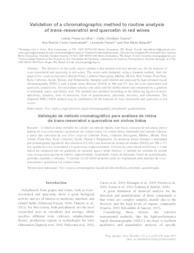Validation of a chromatographic method to routine analysis of transresveratrol and quercetin in red wines.
Validation of a chromatographic method to routine analysis of transresveratrol and quercetin in red wines.
Author(s): SILVA, L. F. da; GUERRA, C. C.; CZERMAINSKI, A. B. C.; FERRARI, L.; BERGOLD, A. M.
Summary: The objective of this work was to validate a fast method with low-solvent use, for the analysis of trans-resveratrol and quercetin in red wines. The wines were prepared, using a classical method, from the grape (Vitis vinifera) cultivars Cabernet Franc, Cabernet Sauvignon, Malbec, Merlot, Petit Verdot, Pinot Noir, Ruby Cabernet, Syrah, Tannat, and Tempranillo. Samples were filtered and analyzed by high-pressure liquid chromatography (HPLC) with a diode array detector (DAD), at 306 and 371 nm, for trans-resveratrol and quercetin, respectively. An octylsilane column was used, and the mobile phase was composed by a gradient of methanol, water, and formic acid. The method was validated according to the following figures of merit: specificity, linearity, limit of detection, limit of quantification, precision, accuracy, and robustness. The proposed HPLC-DAD method may be established for the analysis of trans-resveratrol and quercetin in red wines. Index terms: Vitis vinifera , high-pressure liquid chromatography, polyphenol, quantification. Validação de método cromatográfico para análises de rotina de trans-resveratrol e quercetina em vinhos tintos O objetivo deste trabalho foi validar um método rápido, com baixo consumo de solventes, para a análise de trans-resveratrol e quercetina em vinhos tintos. Os vinhos foram elaborados por método clássico, a partir das cultivares de uva (Vitis vinifera) Cabernet Franc, Cabernet Sauvignon, Malbec, Merlot, Petit Verdot, Pinot Noir, Ruby Cabernet, Syrah, Tannat e Tempranillo. As amostras foram filtradas e analisadas por cromatografia líquida de alta eficiência (CLAE) com detector de arranjo de diodos (DAD), em 306 e 371 nm, quanto ao trans-resveratrol e à quercetina, respectivamente. Utilizou-se uma coluna octilsilano, e a fase móvel foi composta por um gradiente de metanol, água e ácido fórmico. O método foi validado de acordo com as seguintes figuras de mérito: especificidade, linearidade, limite de detecção, limite de quantificação, precisão, exatidão e robustez. O método CLAE-DAD proposto pode ser implantado para análises de transresveratrol e quercetina em vinhos tintos. Termos para indexação: Vitis vinifera, cromatografia líquida de alta eficiência, polifenol, quantificação.
Publication year: 2017
Types of publication: Journal article
Unit: Embrapa Grape & Wine
Observation
Some of Embrapa's publications are published as ePub files. To read them, use or download one of the following free software options to your computer or mobile device. Android: Google Play Books; IOS: iBooks; Windows and Linux: Calibre.
Access other publications
Access the Agricultural Research Database (BDPA) to consult Embrapa's full library collection and records.
Visit Embrapa Bookstore to purchase books and other publications sold by Embrapa.

